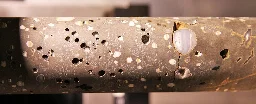Scientists Are Trapping CO2 And Turning It Into Stone
Scientists Are Trapping CO2 And Turning It Into Stone
Researchers have turned carbon dioxide (CO2) into solid rock by injecting volcanic basalt rock with pressurised liquid CO2, and letting natural chemical reactions trigger the transformation.

Researchers have turned carbon dioxide (CO2) into solid rock by injecting volcanic basalt rock with pressurised liquid CO2, and letting natural chemical reactions trigger the transformation.
The technique, which takes two years to achieve, gives scientists another option for capturing and storing the excess CO2 humans are pumping into the atmosphere – and could one day be scaled up to take significant levels of carbon out of circulation.
The research was conducted by a team from the the US Department of Energy's Pacific Northwest National Laboratory (PNNL), and builds on a similar experiment in Iceland earlier this year, which dissolved CO2 in water and injected it into a basalt formation.
In the latest study, undiluted CO2 was used, and much more of it was stored at once: 1,000 tonnes of fluid carbon dioxide.
The PNNL team had already shown that the chemical reactions could happen in lab conditions, but until now, they didn't know how long the reactions would take in a real-world setting.
"Now we know that this mineral trapping process can occur very quickly, it makes it safe to store CO2 in these formations," says researcher Pete McGrail. "We know now that in a short period of time the CO2 will be permanently trapped."